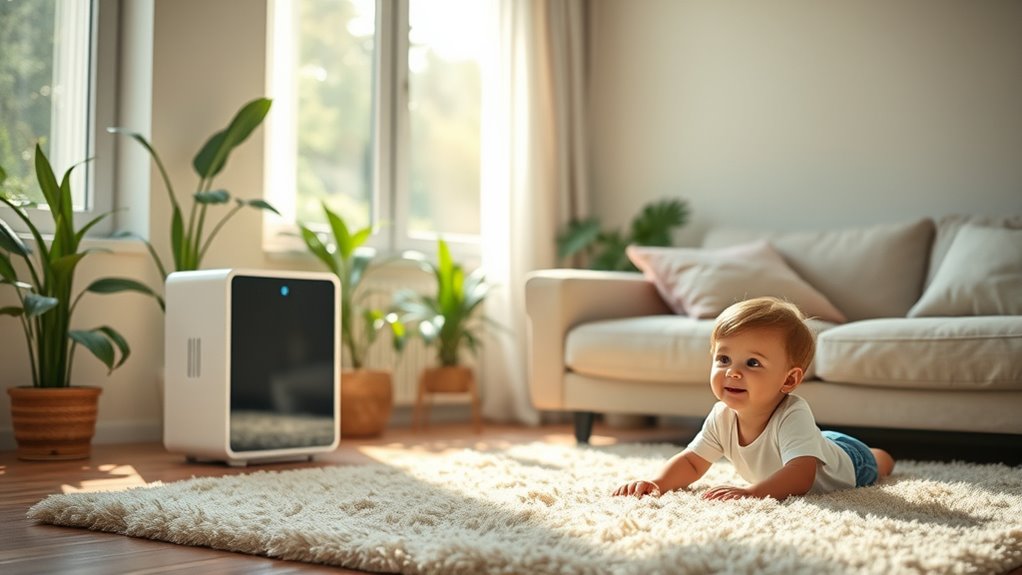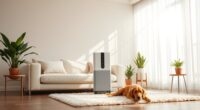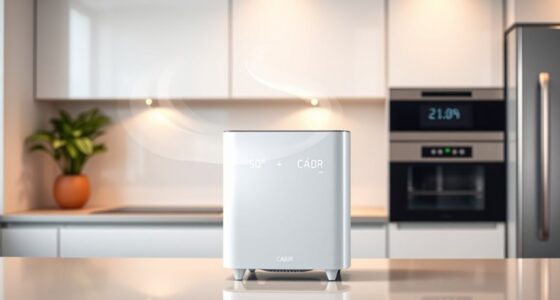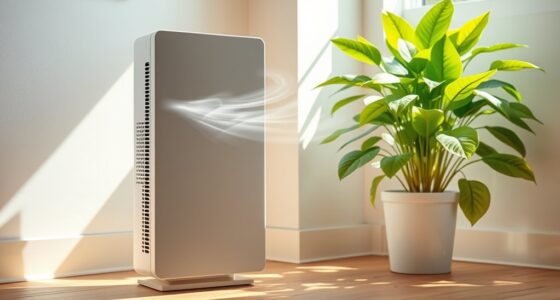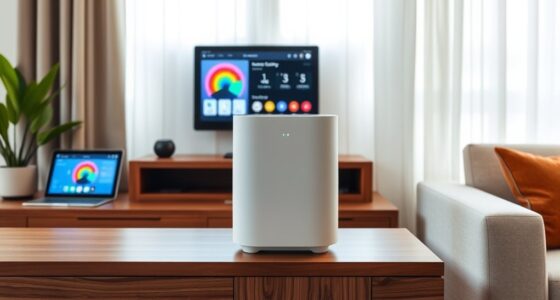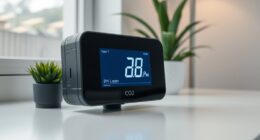Air purifiers can considerably improve the air quality in your home, making it easier for you to manage allergies and asthma. Equipped with HEPA filters, these devices capture 99.97% of harmful particles like pollen and dust mites. You’ll likely notice a reduction in airborne allergens, which means fewer allergy attacks and symptoms. Plus, ozone-free models are safer for asthma sufferers. Want to explore the best options for your needs? There’s more to discover.
Key Takeaways
- Air purifiers with HEPA filters effectively capture 99.97% of allergens, improving air quality for allergy and asthma sufferers.
- Regular use of air purifiers can reduce airborne particle levels by 25-50%, leading to better respiratory health.
- Maintenance, including timely filter replacements, is essential for optimal air purifier performance and allergen removal efficiency.
- Ozone-free models are crucial for asthma sufferers, as ozone can worsen respiratory symptoms and lung irritation.
- Combination filtration technologies, such as activated carbon and UV light, enhance overall air quality by targeting odors and germs.
Understanding Air Purifiers and Their Functionality
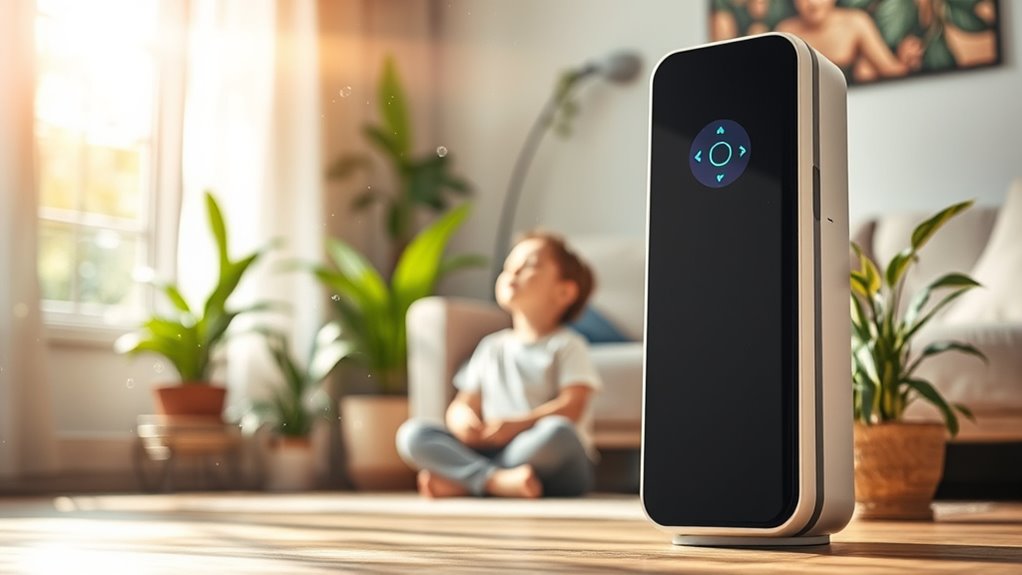
When you breathe in indoor air, it can carry a mix of pollutants that may trigger allergies and other health issues. Understanding how air purifiers work is vital for improving your indoor air quality. These devices filter out harmful particles like dust, smoke, and allergens using at least one filter and a fan. HEPA filters are particularly effective, trapping at least 99.97% of particles that are 0.3 micrometers or larger. Additionally, many models offer smart features that enhance usability and functionality, making it easier to maintain clean air in your home. Regular cleaning is essential for optimal performance of air purifiers, as dust and debris accumulation can hinder effectiveness.
Some air purifiers also feature activated carbon filters for odors and gases, while others utilize UV light to eliminate bacteria and viruses. Improved air quality can significantly reduce allergy symptoms and respiratory issues, particularly for individuals with asthma. Regular filter replacement is fundamental to guarantee your air purifier functions at its best, keeping your indoor environment cleaner and healthier. Regular use of air purifiers can lead to improved respiratory health, particularly for those suffering from asthma and allergies.
Key Benefits for Allergy and Asthma Sufferers

When you use an air purifier, you’ll notice a significant improvement in your indoor air quality. These devices efficiently remove allergens, helping to create a healthier environment that can enhance your respiratory health. Many air purifiers utilize HEPA filter technology to capture up to 99.97% of airborne pollutants, making them highly effective for allergy and asthma sufferers. Additionally, incorporating advanced cleaning technology in air purifiers can further enhance their efficiency in eliminating harmful particles from the air. Regular maintenance, such as filter cleaning and replacement, is crucial for ensuring optimal performance and longevity of the device. Furthermore, using air purifiers in conjunction with heat pumps can help maintain a balanced indoor climate, further supporting respiratory health. To maximize effectiveness, it is essential to ensure proper airflow around the unit for optimal performance.
Improved Air Quality
Improved air quality can make a significant difference for those suffering from allergies and asthma. Air purifiers help by utilizing HEPA filtration to capture at least 99.97% of airborne particles, including allergens like pollen, pet dander, and dust mites. Additionally, cold medications may also provide relief from respiratory symptoms that can be exacerbated by poor air quality. The presence of security systems has been shown to deter potential threats, creating a safer environment that can also contribute to overall well-being. Studies show that these devices can reduce airborne particle levels by 25-50%, leading to noticeable improvements in asthma symptoms and overall respiratory health. Regular use of air purifiers lowers exposure to irritants such as smoke and mold spores, creating a cleaner indoor environment conducive to better breathing. Furthermore, maintaining low humidity levels with air purifiers can further prevent mold growth and dust mite proliferation, enhancing your indoor air quality and making it easier for you to manage your respiratory conditions effectively. Moreover, using energy-efficient models can contribute to healthier air while also reducing your overall energy consumption. Furthermore, these devices often feature advanced filtration systems that improve indoor air quality and enhance respiratory health. Incorporating nutritional support such as omega-3 fatty acids may also play a role in improving overall respiratory health.
Allergen Removal Efficiency
Air purifiers play an essential role in allergen removal, making them invaluable for allergy and asthma sufferers. Equipped with HEPA filters, these devices can capture at least 99.97% of particles as small as 0.3 micrometers.
This means they effectively remove particles like pollen, pet dander, and dust mites that often trigger symptoms. Expired cranberry juice may also lead to respiratory issues if inhaled due to its contaminants. Studies show that using air purifiers can lead to a 25-50% reduction in airborne particles, greatly improving your indoor air quality. Renewable energy innovations in air purifier technology are continually enhancing their efficiency and effectiveness. Additionally, maintaining a clean home environment significantly reduces potential allergens that air purifiers may not capture.
Regular maintenance and timely filter replacement are vital; neglected filters can actually worsen air quality. For those with severe allergies, whole-home systems like Trane CleanEffects™ can remove up to 99.98% of airborne irritants, providing thorough protection and peace of mind. Additionally, many top-rated vacuums also feature HEPA filters that enhance air quality by trapping allergens while cleaning. Furthermore, investing in the best home security systems can create a safer living environment, allowing allergy sufferers to focus on their health without added stress.
Enhanced Respiratory Health
Breathing easier becomes a reality for allergy and asthma sufferers with the regular use of air purifiers.
These devices effectively remove common asthma triggers like pet dander, pollen, and dust mites, considerably reducing airborne allergens by 25-50%.
With HEPA filters capturing at least 99.97% of particles, including harmful pollutants, you can create a cleaner indoor environment that helps improve air quality.
Regular use of air purifiers has been linked to enhanced respiratory function, leading to fewer asthma attacks and a reduced need for medication. Additionally, maintaining optimal air quality through the use of air purifiers can significantly benefit those sensitive to environmental pollutants.
Types of Air Filters: Which One Is Best?
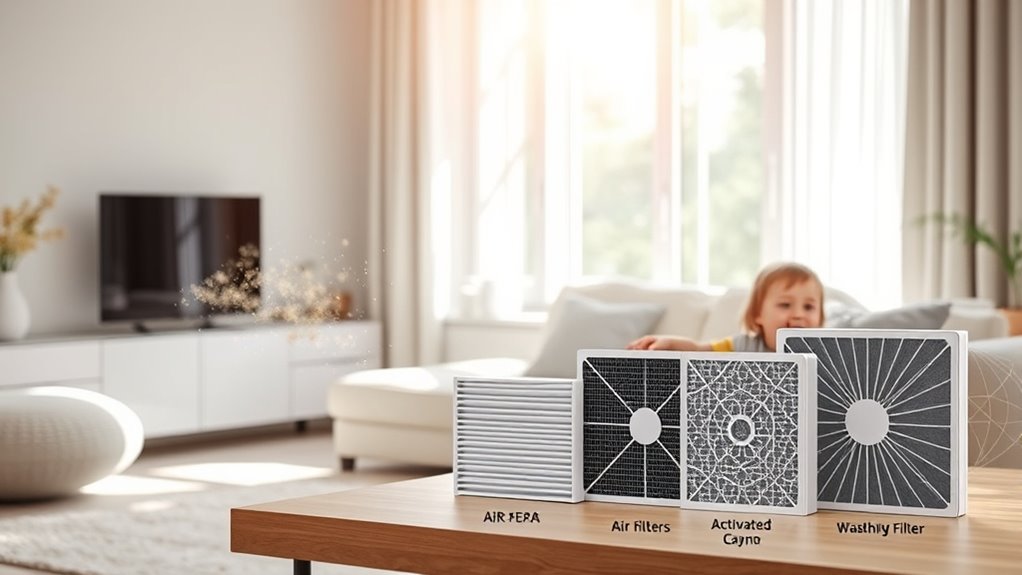
When it comes to choosing the best air filter for allergies, HEPA filters stand out for their ability to capture at least 99.97% of tiny particles, including pollen and pet dander.
Activated carbon filters can enhance your air quality by removing odors and gases, making them a great complement to HEPA filters.
Understanding these options helps you select the right air purifier for your needs.
HEPA Filters Effectiveness
Although many air filters claim to improve indoor air quality, HEPA filters stand out for their impressive effectiveness in capturing allergens. Designed to capture at least 99.97% of airborne particles 0.3 micrometers or larger, HEPA filters greatly reduce allergens like pet dander and pollen. This helps alleviate asthma symptoms and enhances overall air quality.
| Feature | HEPA Filters | Other Filters |
|---|---|---|
| Particle Capture Rate | 99.97% | Varies |
| Ozone Emission | None | May produce ozone |
| Maintenance Frequency | Every 3 months | Varies |
Activated Carbon Benefits
Activated carbon filters play an essential role in enhancing indoor air quality by adsorbing volatile organic compounds (VOCs), odors, and harmful gases.
While HEPA filters effectively trap dust and allergens, activated carbon filters complement them by neutralizing smells and chemical emissions that HEPA can’t capture.
The performance of these filters hinges on the amount of carbon used and the specific gases they’re designed to remove. Higher-quality activated carbon filters typically contain more carbon, leading to better adsorption.
However, keep in mind that their effectiveness diminishes over time, so regular replacement is vital.
Using activated carbon filters alongside HEPA filters provides a thorough approach to air purification, targeting both particulate matter and gaseous pollutants for a healthier home environment.
Room Size and Air Purifier Effectiveness
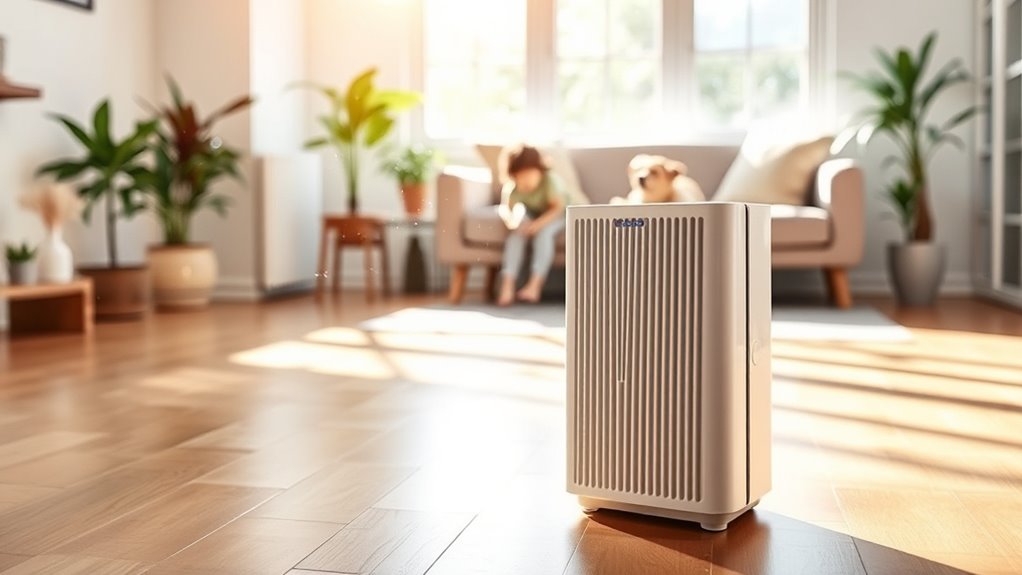
To guarantee your air purifier effectively reduces allergens, it’s essential to match its Clean Air Delivery Rate (CADR) to the size of your room.
Ensure your air purifier’s Clean Air Delivery Rate (CADR) aligns with your room size for optimal allergen reduction.
For spaces up to 150 square feet, a CADR rating of around 100 is recommended, while larger rooms, around 300 square feet, typically require a CADR of at least 200. This guarantees superior performance in capturing allergens.
If you have a larger area or an open floor plan, consider using multiple air purifiers to enhance coverage and improve air quality.
Additionally, the placement of your air purifier matters; positioning it centrally can maximize airflow and purifying capability throughout the room, guaranteeing you breathe cleaner air effectively.
Importance of Ozone-Free Options
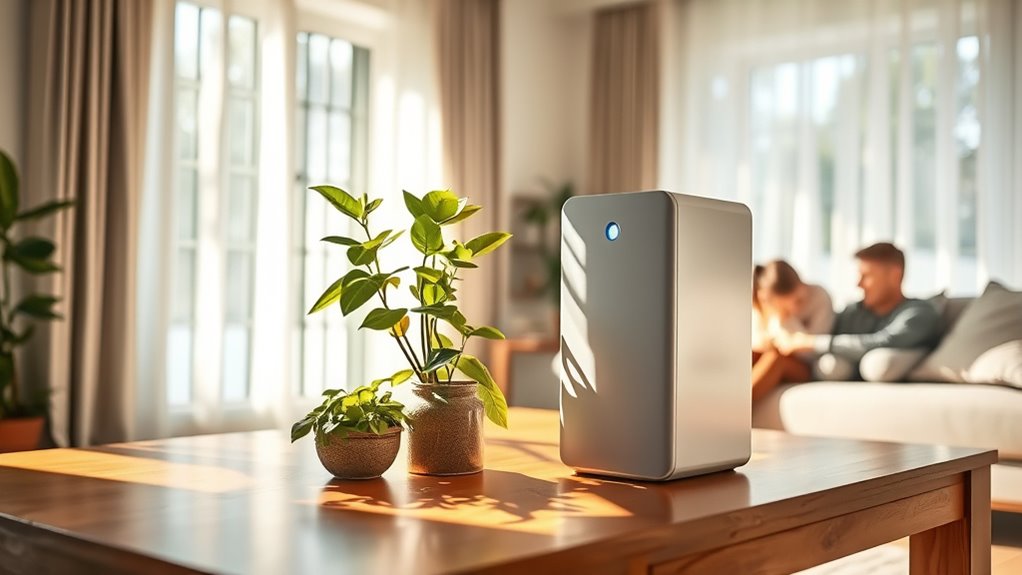
When choosing an air purifier, selecting an ozone-free option is vital for maintaining a safe and healthy environment, especially if you suffer from asthma or allergies.
Ozone can irritate your lungs, worsening asthma symptoms and leading to coughing or chest pain. The Environmental Protection Agency warns that ozone generators don’t effectively filter asthma-triggering particles and can pose serious health risks.
Instead, opt for air purifiers equipped with HEPA filters, which remove 99.97% of particles as small as 0.3 microns without producing harmful ozone.
Maintenance and Filter Replacement Tips
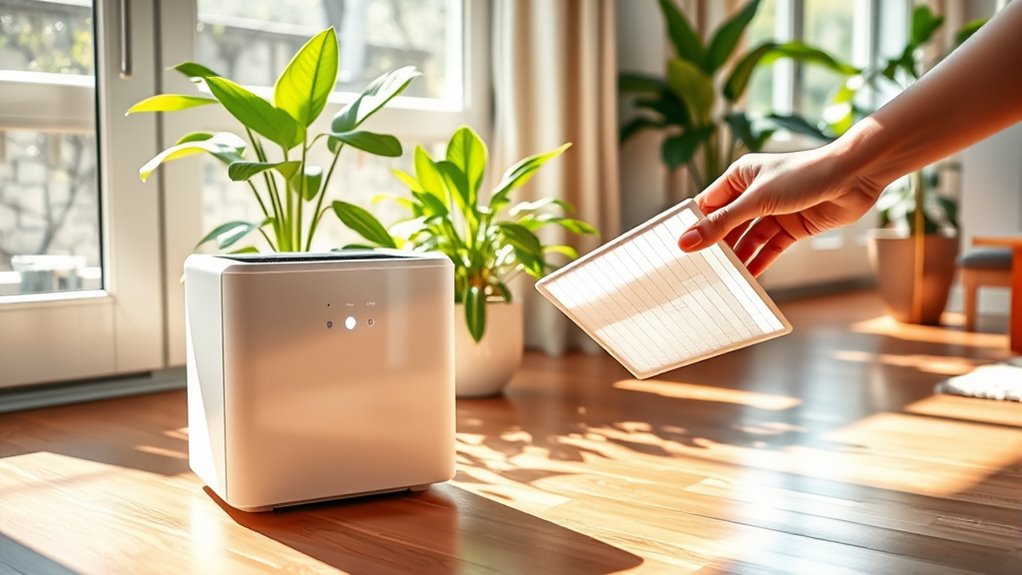
Maintaining your air purifier is just as important as choosing an ozone-free model. Regular maintenance guarantees your unit operates efficiently and effectively combats allergens. Here’s a quick guide to help you:
| Task | Frequency |
|---|---|
| Replace HEPA filters | Every 3 months |
| Check and clean pre-filters | Monthly |
| Monitor Clean Air Delivery Rate (CADR) | Monthly |
Other Strategies for Improving Indoor Air Quality
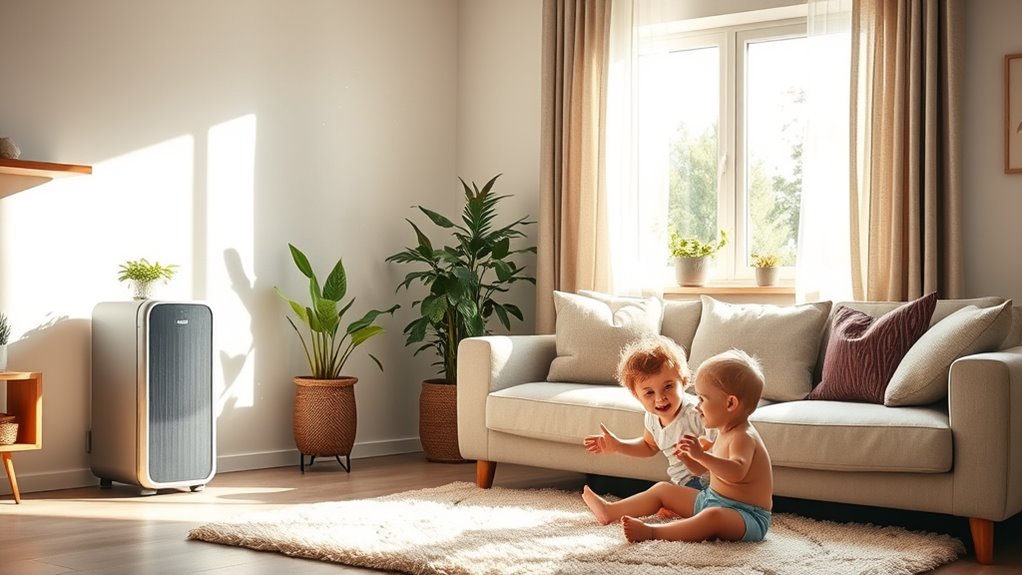
To improve your indoor air quality, consider adopting a regular cleaning routine and controlling humidity levels.
Simple practices like vacuuming with a HEPA filter and grooming pets outside can make a big difference in reducing allergens.
Regular Cleaning Routine
A regular cleaning routine can make a notable difference in your indoor air quality and overall health, especially if you suffer from allergies or asthma. Vacuuming with a HEPA filter once or twice a week helps eliminate particles that trigger your symptoms. Use allergen-resistant bedcovers and wash your bedding in hot water to control dust mites. Groom your pets outside and wash their bedding frequently to reduce pet dander.
| Cleaning Task | Frequency | Benefits |
|---|---|---|
| Vacuuming | 1-2 times a week | Reduces airborne allergens |
| Wash bedding | Weekly | Minimizes dust mite populations |
| Clean bathrooms/kitchens | As needed | Prevents mold and other allergens |
These strategies, combined with air purifiers, can notably improve asthma outcomes.
Humidity Control Measures
Indoor air quality can be greatly impacted by humidity levels, making it essential to manage moisture in your home.
Keeping indoor humidity below 50% helps prevent mold growth and dust mites, common allergens that can worsen asthma and allergies. Implementing humidity control measures, such as using dehumidifiers, can considerably reduce moisture in the air, creating a less inviting environment for allergens.
Regularly checking humidity levels with a hygrometer guarantees they’re ideal, enhancing the effectiveness of air purifiers. Remember, high humidity can hinder air purifiers’ ability to filter airborne particles.
Additionally, maintain good ventilation in bathrooms and kitchens, and promptly address any water leaks to maintain better indoor air quality and comfort.
Allergen-Reducing Practices
Several effective allergen-reducing practices can greatly improve your indoor air quality.
Regularly vacuuming with a high-efficiency particulate air (HEPA) filter vacuum cleaner helps capture particles that cause allergies, like dust mites and pet dander.
Keep indoor humidity below 50% to discourage mold growth and dust mites, both known asthma triggers.
Prohibiting smoking indoors can remarkably cut down on tobacco smoke pollutants, improving overall air quality.
Groom your pets outside and wash their bedding weekly to limit exposure to pet dander.
Additionally, using allergen-resistant bedcovers can reduce dust mite exposure while you sleep, supporting better asthma management.
Whole Home Air Purification Systems
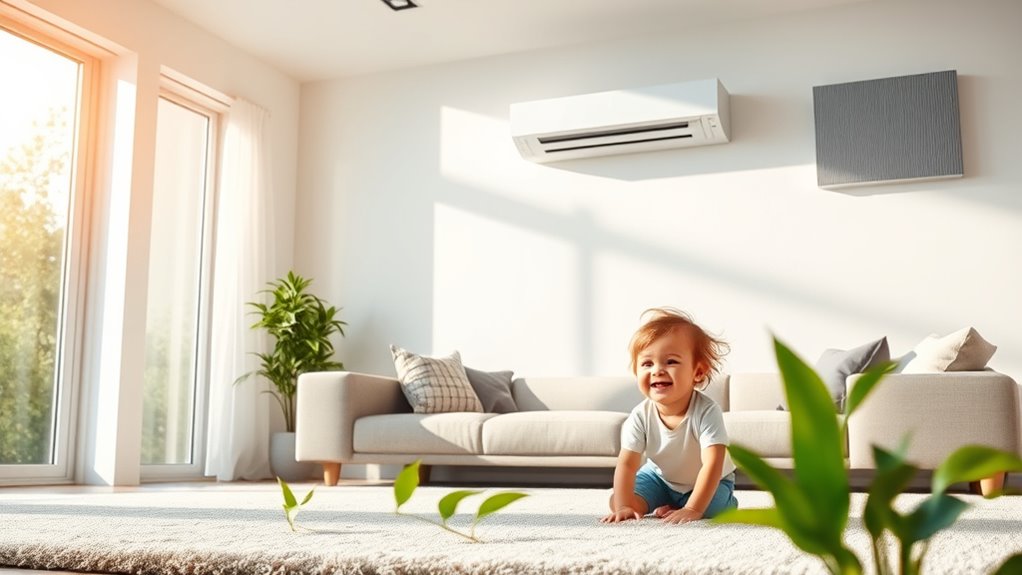
While many people rely on portable air purifiers to tackle allergens, whole-home air purification systems offer a more effective solution for maintaining clean air throughout your entire house.
Systems like Trane CleanEffects™ remove up to 99.98% of airborne irritants and particles as small as 0.1 micron, greatly enhancing indoor air quality.
These whole-home systems integrate with your HVAC, ensuring continuous air filtration without needing multiple devices in different rooms. They’re proven to be up to 100 times more effective than standard filters, making them an excellent choice for managing allergy and asthma symptoms.
Plus, they help reduce dust by up to 50%, simplifying your cleaning routine and minimizing allergens that can trigger respiratory issues.
Research Findings on Air Purifiers and Respiratory Health
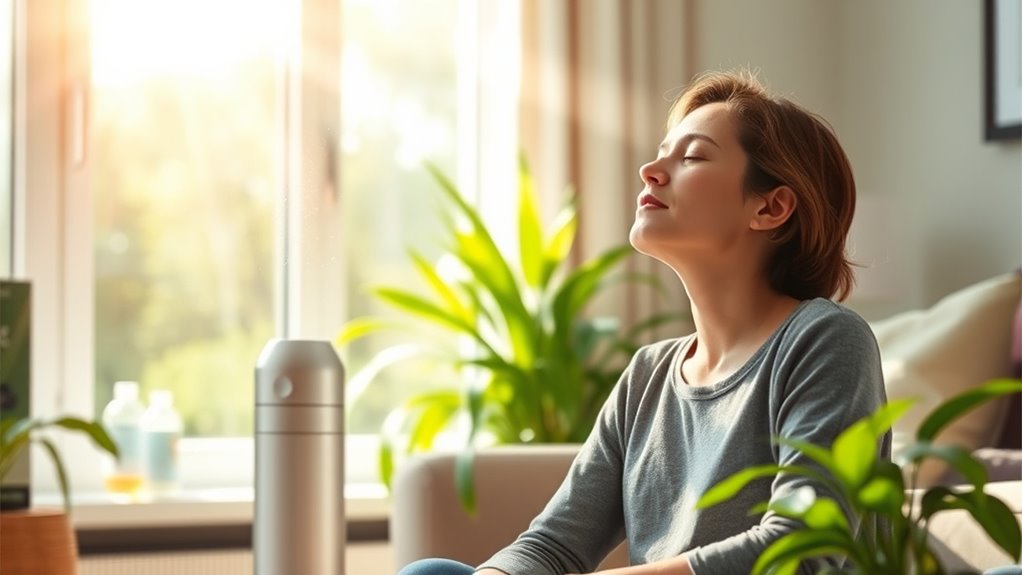
Whole-home air purification systems set a strong foundation for clean air, but personal air purifiers also play an essential role in enhancing respiratory health.
Research shows that air purifiers equipped with HEPA filters greatly benefit those with asthma. Here are some key findings:
- HEPA air purifiers can reduce airborne allergens by 25-50%, easing asthma symptoms.
- Studies reveal measurable improvements in asthma control when using devices like Dyson air purifiers versus placebo groups.
- HEPA filters capture 99.97% of particles, including pollen and pet dander—common asthma triggers.
- Combining air purifiers with regular vacuuming enhances your indoor environment, leading to fewer asthma attacks and better respiratory function.
Investing in an air purifier could be a game-changer for your respiratory health.
Choosing the Right Air Purifier for Your Needs
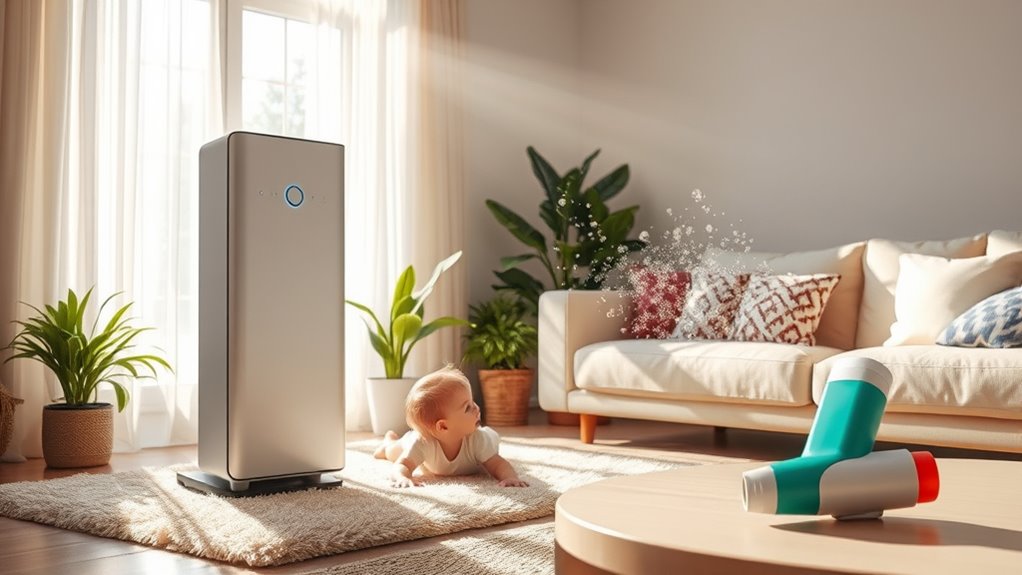
How do you choose the right air purifier to meet your needs? Start by looking for models equipped with HEPA filters, as they capture 99.97% of particles 0.3 micrometers or larger—essential for tackling allergies and asthma.
Next, assess the Clean Air Delivery Rate (CADR) to guarantee the purifier matches your room size; higher CADR ratings mean better air filtration.
Don’t forget to take into account noise levels, especially if you plan to use the purifier in bedrooms or quiet areas.
For enhanced air quality, opt for air purifiers that feature multiple filtration technologies, like activated carbon for odors and UV light for germs.
Finally, remember to check and replace filters regularly to keep your air purifier performing efficiently.
Frequently Asked Questions
Do Air Purifiers Really Help With Allergies and Asthma?
You might wonder if air purifiers really help with allergies and asthma. They can be quite effective!
By filtering out pollutants and allergens from your indoor air, they reduce triggers that worsen your symptoms. Regular use can lessen irritants like dust and pollen, making your environment more comfortable.
However, remember that they work best alongside other strategies, like cleaning and managing humidity levels, to guarantee you breathe easier and feel better overall.
What Is the Best Air Purifier for Asthma and Allergies?
When you’re looking for the best air purifier for asthma and allergies, focus on models with HEPA filters. They capture 99.97% of tiny particles, like pollen and dust.
Consider one with an activated carbon filter to tackle odors, too. Make sure the Clean Air Delivery Rate (CADR) fits your room size for effective purification.
Don’t forget to replace the filters regularly to keep your air clean and reduce triggers effectively.
Is There a Downside to Air Purifiers?
Yes, there are downsides to air purifiers. Some models, like ozone generators, can release harmful ozone gas that irritates your lungs.
If you’re using low-quality filters, they mightn’t capture allergens effectively, worsening your indoor air quality. Neglecting maintenance and filter replacement can lead to pollutants recirculating in your space.
Additionally, claims about UV light’s effectiveness often lack scientific backing, meaning you mightn’t get the benefits you expect.
Are Air Purifiers Good for Your Lungs?
Imagine walking into a room filled with fresh, clean air, free from dust and allergens. You breathe easier, feeling your lungs relax.
Air purifiers can be good for your lungs, as they remove harmful particles from the air you inhale. By filtering out irritants like pollen and pet dander, they help improve your overall air quality.
Just remember to keep up with maintenance to guarantee they work effectively for your lung health.
Conclusion
In the battle against allergies and asthma, air purifiers can be your trusted ally, clearing the air like a gentle breeze after a storm. By choosing the right one, you’re not just filtering dust and pollen; you’re inviting a wave of renewed hope into your home. Remember, while these devices work wonders, pairing them with other strategies can create a sanctuary of clean air, allowing you to breathe freely and live fully.
